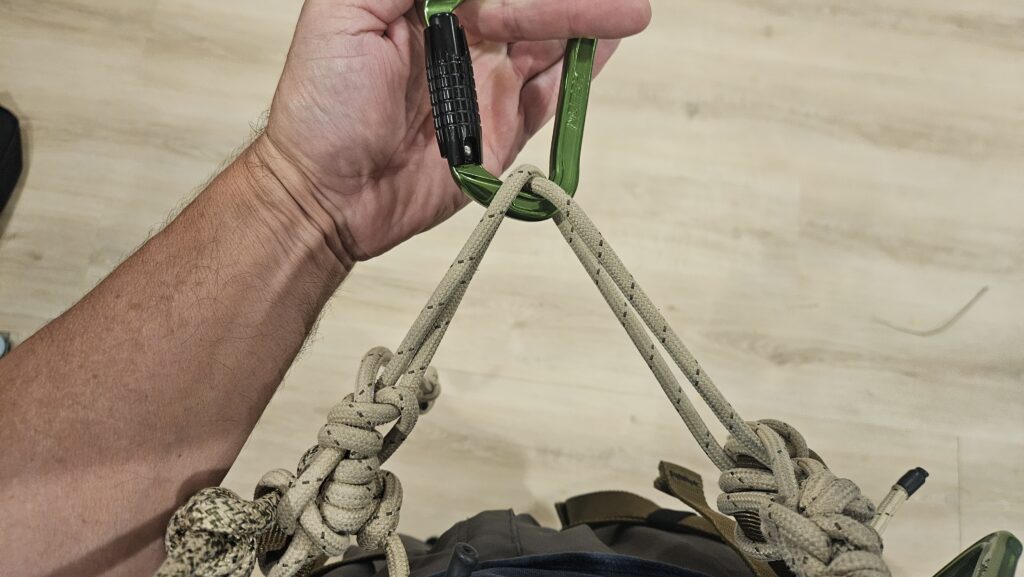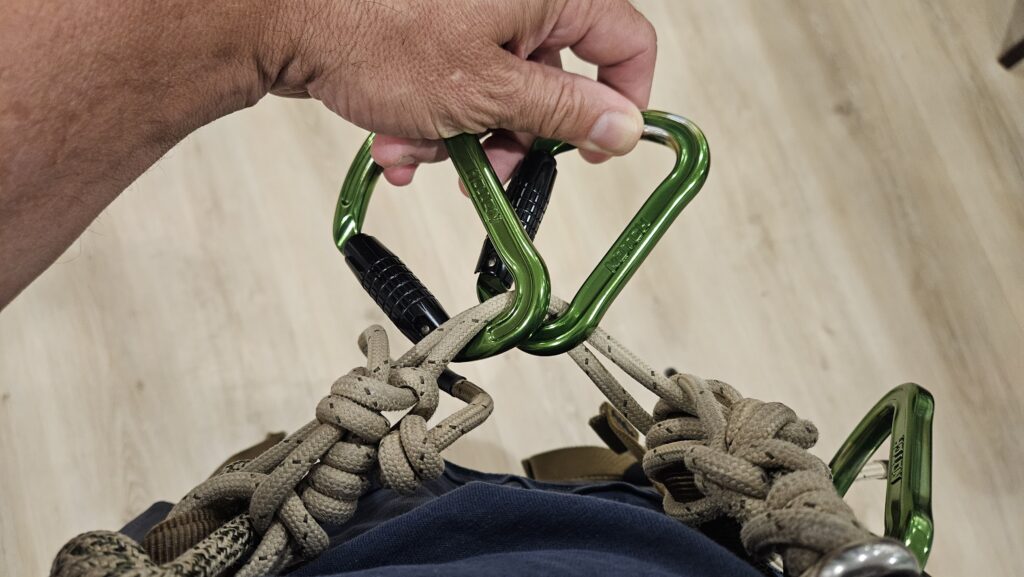Page Contents:
Overview
The “bridge” is part of our saddle, specifically the rope that connects our left and right ‘bridge loops’. It typically has a carabiner in the center and is used to connect us to our lifeline or tether. Many saddle hunters are taking an unnecessary chance with their safety by NOT having their bridge connected to an anchor on the tree during the entire climb. A lineman’s belt is no substitute.
Although a bridge comes with our saddle, it is a replaceable component. JRB is an advocate of having 2 bridges on our saddle (redundant bridges). The longer/upper bridge is the primary bridge and the shorter/lower bridge is the backup, used in rappel, and alternating anchor techniques such as hitch climbing. Whether the bridges are adjustable or fixed in length, it is important that the bridges are of different lengths, with at least 6″ of separation between the carabiners, ensuring that rappel can be executed without interference between the bridges.
Do not attempt any of these designs if you are not comfortable in tying the necessary knots and testing your bridge before you use it to climb.
Elements
Depending on the design chosen, the elements for building a bridge can be found on these pages:
The Carabiners page also includes information on Swivel Options. A Swivel is not mandatory but is especially useful in DSRT, ensuring that our carabiner will always be in a preferred position.
Current Bridge Designs
This section contains the designs that JRB is currently using and recommending. JRB is currently using #1 as his primary bridge and #2 as his short bridge.
Note that both bridges are adjustable: 1) Making our main bridge as long as possible will minimize the squeezing effect of a saddle and the ‘hip pinch’ associated with it. 2) The Blake’s hitch tensioner bridge can be made extremely short as possible and not allow the friction hitch to be unintentionally tended by the carabiner which is of benefit in JRB Hitch Climbing and Stick Climbing, also eliminating the need for a Lineman’s belt.
Both bridges stay in place on both sides of the saddle, which was a problem with some prior designs.
1. Main Bridge Design, 2025
In 2025, JRB combined the best tools in our toolbox for a bridge design based on the Compact, Non-Jamming JRB Ascender Hitch. It is long enough to go over our head and act as suspenders. The addition of the clove hitch ensures that it stays in place on our bridge loops (better than the “Double Adjustable Bridge” shown below). The friction hitch is optimally compact (and notably smaller than the Longhorn Agile Bridge shown below). The design uses:
- 8′ of 8mm rope (your height + 2′)
- 6′ of 6mm Sterling TRC cord, and 36″ working end
- If using 9-9.5 mm rope, use 78″ of cord and 38″ working end.
2. Blakes Hitch Tensioner Bridge (2025)
The Blakes Hitch Tensioner Bridge is JRB’s preference for an adjustable 2nd/redundant bridge. It can be made extremely short and not be susceptible to the bridge carabiner unintentionally tending the friction hitch when moving. Because it is woven into the main bridge, it stays in place better than prior designs. Note that the BHT bridge length must be set before the climb because it cannot be reliably adjusted when load is on it.
The optimal length of cord to construct it could vary based on the design of your saddle, given that your saddle might have longer or shorter bridge loops. It is best to use more and then trim it down if appropriate. The following length recommendations are 4″ longer than JRB uses in his own saddle:
- 6 mm cord: use 84″ w/32″ working end
- 7 mm cord: use 88″ w/36″ working end
Viewed from the perspective of the climber, this photo shows how JRB keeps the BHT bridge normally, in a relatively short position, with the Carabiner set in transverse orientation, with the cords crossing inside of it, ready to accept the Best Friend loop or Munter friction hitch in both DSRT and SRT climbing. In order to ensure no interference during rappel, the long bridge must always be at least 6″ longer than the short bridge, even longer if using Rappel Device other than the Munter Friction Hitch.

When Hitch Climbing or Stick Climbing, because of the ability to get the BHT bridge so compact, JRB prefers to use the it as the primary bridge (until the final position is reached). It is drawn very short, allowing greater stability during the climb. The carabiners capture both strands of the bridge. When engaging the friction hitch with the carabiner, also engage the rope itself.

Simple Redundant Bridge Options
In this 2024 video, JRB outlines 10 device options that can be used in many configurations to construct a permanent or improvised redundant / backup bridge.
A 24 inch (60cm) sling (runner) with a girth hitch on one bridge loop and a carabiner on the other makes a solid Bridge for impromptu or emergency use. The concept was also demonstrated in the following video: Self Rescue After Loss of Footing. The following products can be used to make an impromtu bridge. Note that these are at RockNArbor, not ApeCanyon; use the JRB10 coupon code.
Historical Bridge Designs
The sections below document the other bridge designs that JRB has introduced.
Longhorn Agile Bridge (2024)
The Longhorn Agile Hitch can be used in an adjustable bridge. It performs great, but is larger/longer than ideal. (This is the primary reason that JRB went back to the JRB Ascender in 2025).
The length of the rope used for the bridge should be approximately your height plus 2 feet. The amount of cord needed depends on the diameters:
- For 6mm cord on 8mm rope, use 96″ of cord, with 12″ ends to start the Longhorn.
- For 7mm cord on 9.5mm rope, use 120″ of cord, with 14″ ends to start the Longhorn.
Blakes Hitch Tensioner (2024, original)
For reference, below is the ORIGINAL design for the Blakes Hitch Tensioner Bridge, introduced in 2024. It remains viable, but v2 (described above) is easier to tend. This design used:
- 6mm cord: 32″ working end
- 7mm cord: 33.5″ working end
- 8mm cord: 35″ working end
For reference, this is the predecessor video detailing the Blake’s Hitch Tensioner, which used a 32″ working end on 7mm cord.
Double Adjustable Bridge (2023)
This is the 2023 design for a double bridge, which utilized the JRB Ascender Hitch. Use a length of rope that is approximately double your height (approximately 12 feet), and two 72″ lengths of cord.
Non-mechanical, adjustable bridge (2022)
In 2022, JRB introduced this design, using, 9 ft or 108 in or 274 cm of 7mm cord to construct it. In practice, most climbers keep one bridge shorter than the other and the short one is constructed with 7ft (213 cm). 24″ (61cm) is used as the working end when starting the Blakes Hitch. This bridge does not cinch in place on the bridge loops and for that reason, it was replaced with newer designs.
The Original Redundant Bridge (2020)
This video shows JRB’s initial concept for a simple, non-adjustable, 2nd (short) bridge. The design uses 4 ft (122 cm) of cord, closed into a fixed loop with a hunters bend, capturing both bridge loops. The Hunter’s Bend can be untied and adjusted as necessary so as to ensure that the short bridge is adequately shorter than the long bridge. If a more secure bend is desired, consider using 6 ft (183 cm) and a sliding triple fisherman’s bend (video available), and consider a carabiner on the end, ensuring it is removeable and can be untied. Get the length set, then trim the ends as appropriate.